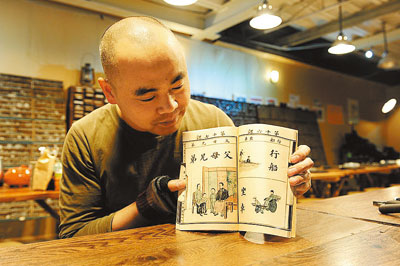
CHINA is known for its “four great inventions”: paper, gunpowder, the compass and movable type printing.
Modern versions of paper, gunpowder and the compass are still widely used today, but many people may have only seen movable type printers in books and on TV.
However, there are people who still have a strong attachment to this ancient artistic technique, which can be traced back over 1,000 years ago in China — 400 years before the Gutenberg press was invented in Europe. Ruan Tongmin, a 35-year-old graphic designer who works in the printing industry, is one of these people, and he decided to do something to promote this technique and traditional print culture.
In 2012, he opened China’s first private printing museum, Time Printing, at a small warehouse in Qingdao, Shandong Province.
“I have loved printing since I was a little boy. When I was a child, I often went to play in my uncle’s office, and he worked at a printing factory. I was fascinated by all those tiny lead blocks,” Ruan said.
The museum now has nearly a million different character blocks, almost 20 sets of typographic tools and about 10 ancient block making machines. “It was not easy to collect all these things. I went to many printing factories across the country and persuaded them not to abandon these precious pieces of history,” he said. “The problem was that many factories lacked awareness about the need to preserve these cultural relics, so they just got rid of the machines and tools as they became obsolete. It was very difficult to find factories that still owned some of these machines.”
In Ruan’s opinion, books printed by movable printing techniques are more artistic than those printed by modern machines. “They have much more character, and they also demonstrate the printers’ skills in terms of art and printing,” he said.
The museum is now a popular place for children. Every weekend, many parents and teachers bring their young students to the museum. “They can create their own books with tools at the museum. It helps them learn about traditional culture and helps increase their interest in reading,” he said.
It is easy for students to create their own books with help from Ruan. “In ancient times, the difficult part was not printing but making the character blocks. However, this problem was solved by modern molding techniques,” he said.
For Ruan’s own products, it can take about a week to print a book because he has to mix his own colors. “Ancient books were black and white, so they did not require so much work. But if we want to make a color book, we have to print different colors separately, and that requires time, patience and skill,” he said.
Ruan’s dream of having a moveable type printing museum has not been an easy journey.
Ruan used his own money to get the museum started, and he faced huge financial losses the first year. “It is difficult for individuals to make money in the culture industry because the starting investments are always very big and it takes time to earn a profit. It would be better if projects like this could get government support,” he said. “For example, if the government can give some preferential policies, such as rent deduction or financial support, they would help private museums and workshops survive.”
(Wang Yuanyuan)
|

